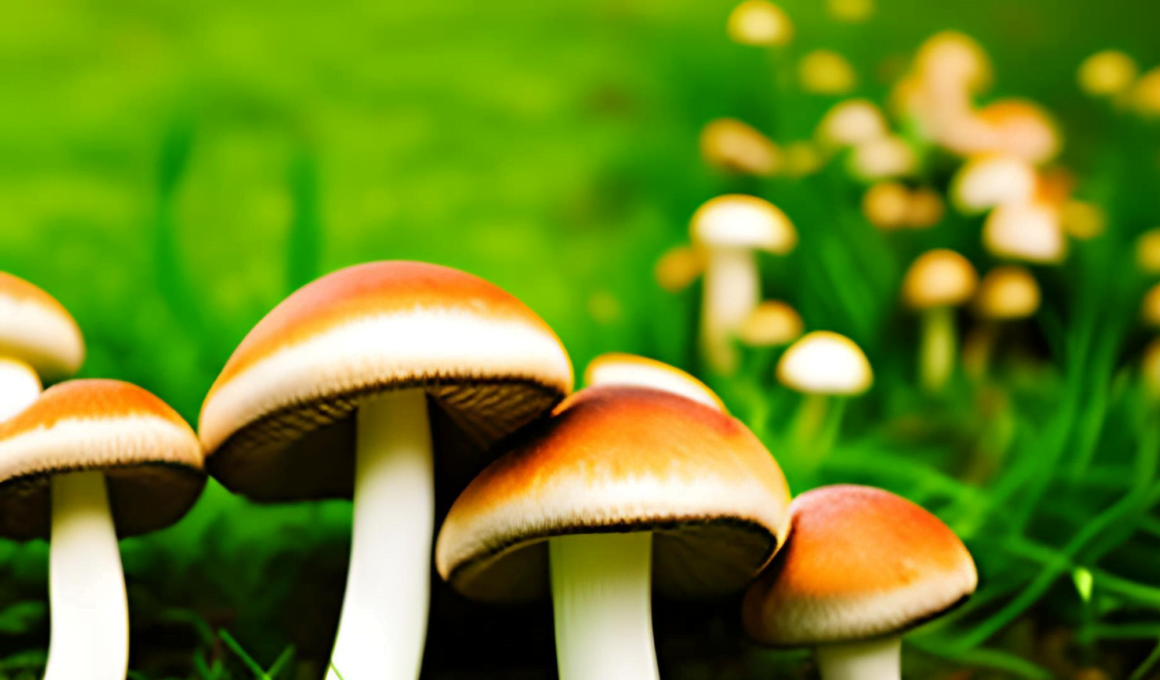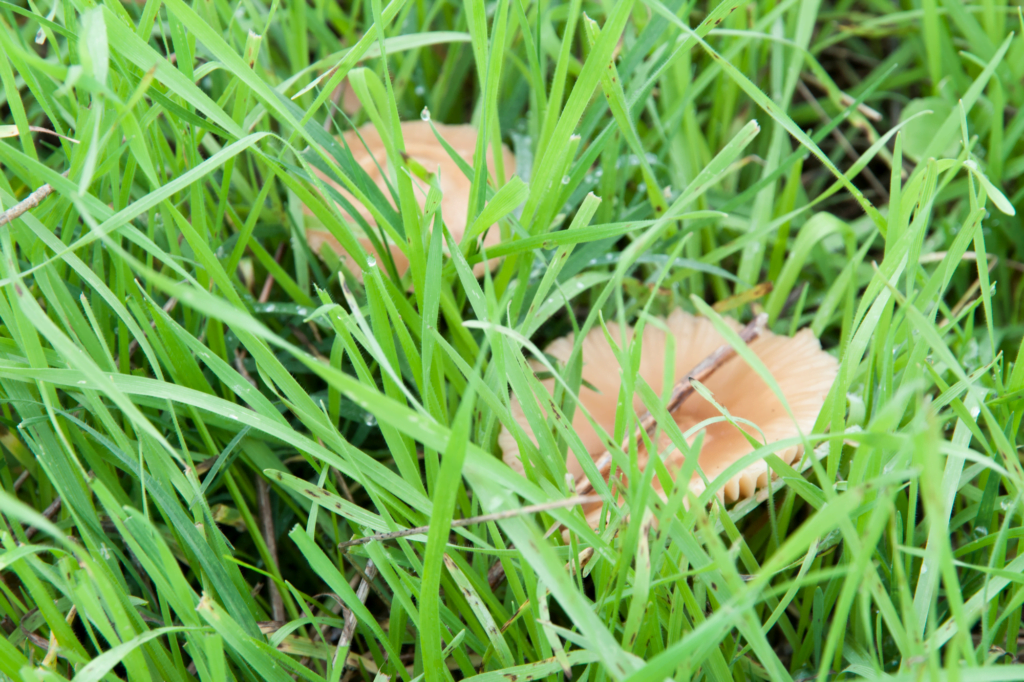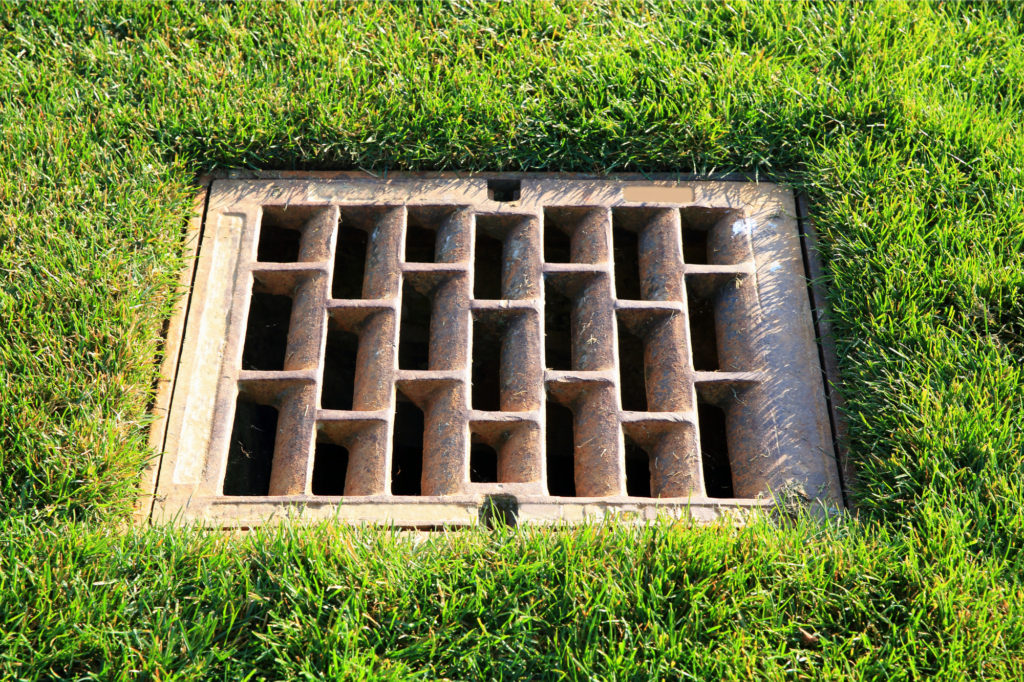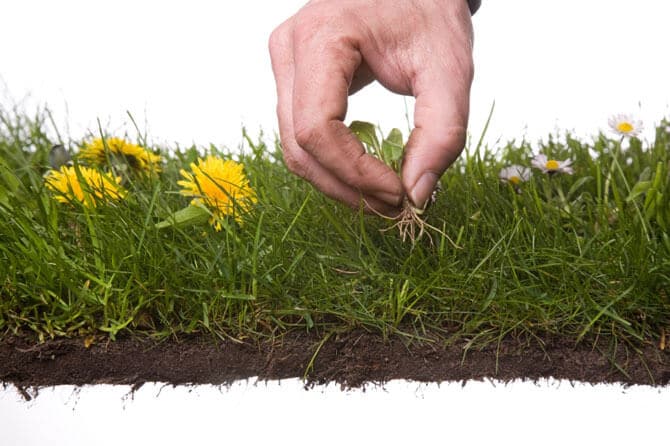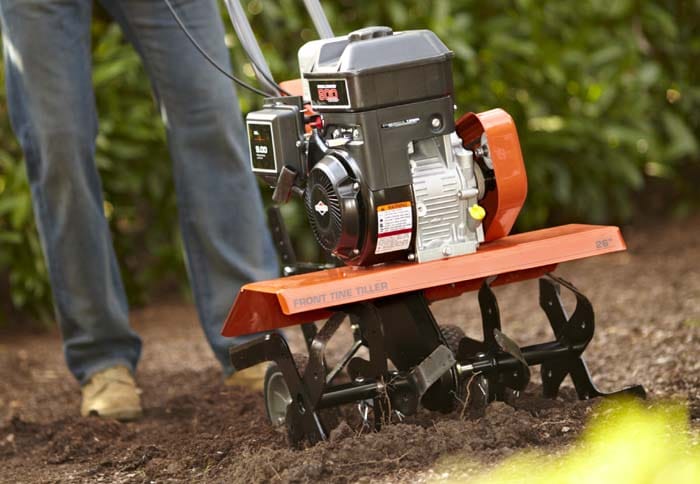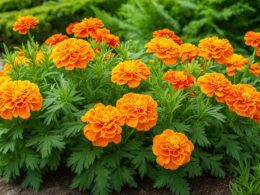Are you tired of those pesky mushrooms popping up in your lawn? Don’t worry, we’ve got you covered! In this article, we will show you how to successfully get rid of mushrooms in your lawn.
By following these simple steps, you can have a beautiful and mushroom-free lawn in no time.
First, it’s important to identify the type of mushroom you’re dealing with. Some mushrooms are harmless, while others can be toxic. Once you know what you’re dealing with, you can move on to the next step – removing existing mushrooms. This can be done by simply picking them or mowing them down.
Next, you’ll want to improve your lawn’s drainage. Mushrooms thrive in moist environments, so making sure your lawn has proper drainage will help prevent them from growing. Adjusting your lawn care practices, such as watering and fertilizing, can also help keep mushrooms at bay.
If all else fails, you can apply fungicides to your lawn. These chemicals will kill the mushrooms and prevent them from coming back. However, if you prefer a more natural approach, there are also several homemade remedies you can try.
Remember, maintaining a healthy lawn is key to preventing mushrooms. Regularly mowing, aerating, and dethatching your lawn will help keep it in tip-top shape. And if you’re still struggling, don’t hesitate to consult a professional for expert advice.
By following these steps and taking the necessary precautions, you can have a mushroom-free lawn that is safe for you and your family to enjoy.
So, let’s get started on reclaiming your lawn from those unwanted fungi!
Quick Summary
- Identify the type of mushroom in your lawn and differentiate between edible and harmful mushrooms.
- Remove existing mushrooms by picking or mowing them down and regularly maintain the lawn by mowing, aerating, and dethatching.
- Improve lawn drainage to prevent mushroom growth by installing drainage systems or aerating the soil.
- Consider using fungicides as a last resort and consult a professional for expert advice if needed.
Identify the Type of Mushroom
Now it’s time to figure out what kind of mushroom is causing mischief in your beautiful lawn! Identifying the type of mushroom is crucial for effectively getting rid of them.
First, let’s talk about differentiating edible mushrooms from the ones that can be harmful. While it might be tempting to taste or experiment with mushrooms growing in your lawn, it’s important to remember that some mushrooms can be poisonous. To stay safe, it’s best to avoid consuming any wild mushrooms unless you have expertise in identifying them.
Next, let’s understand the growth patterns of mushrooms. Mushrooms are the fruiting bodies of fungi that grow from mycelium, a network of thread-like structures buried in the soil. They thrive in moist, shaded areas and prefer decomposing organic matter like dead roots or thatch. By observing the shape, color, and texture of the mushroom, you can get clues to its species. Take note of the cap shape, gill or pore arrangement, and the presence of a stem or ring. Additionally, consider the time of year the mushrooms appear, as some species have specific growing seasons.
By identifying the type of mushroom growing in your lawn, you can take appropriate measures to get rid of them effectively. Remember, safety should always be a priority when dealing with mushrooms, so be cautious and avoid consuming any unfamiliar varieties.
Remove Existing Mushrooms
First, you’ll want to take a close look at your lawn and notice any existing mushrooms scattered amongst the grass. Removing these mushrooms is an important step in preventing future mushroom growth. Here are some tips to safely remove existing mushrooms:
- Wear gloves: Protect your hands from any potential allergens or toxins that mushrooms may contain.
- Use a trowel or a small shovel: Gently dig around the base of the mushroom to loosen the soil and roots.
- Remove the entire mushroom: Be sure to remove the entire mushroom, including the stem and any attached mycelium, to prevent regrowth.
It’s important to be cautious when removing mushrooms to avoid common mistakes that can worsen the problem. Here are some common mistakes to avoid:
- Avoid spraying with water: Water can actually help mushrooms spread their spores, so it’s best to avoid using water when removing them.
- Don’t just mow over them: Mowing over mushrooms may scatter their spores, leading to more mushroom growth in the future.
- Don’t use chemical fungicides: While they may temporarily get rid of mushrooms, they can also harm beneficial organisms in the soil and disrupt the natural balance of your lawn.
By following these tips and avoiding common mistakes, you can successfully remove existing mushrooms from your lawn and help prevent their future growth.
Improve Lawn Drainage
To enhance the health of your lawn, it’s crucial to address the issue of poor drainage. Proper lawn drainage is essential in preventing the growth of mushrooms and ensuring a safe outdoor environment.
Here are two effective methods to improve your lawn drainage and keep those pesky mushrooms at bay:
- Install drainage systems: Consider installing a French drain or a dry well to redirect excess water away from your lawn. These systems help prevent water from pooling and creating a damp environment that mushrooms thrive in. It’s important to consult a professional to ensure proper installation and functionality.
- Soil aeration techniques: Aerating your lawn allows water to penetrate the soil more effectively, reducing surface water accumulation. This can be done by using a lawn aerator or by manually creating small holes throughout the lawn. Aeration promotes healthy root growth and improves overall soil drainage.
To better understand the impact of these techniques, take a look at the table below:
| Method | Benefits | Precautions |
|---|---|---|
| Drainage systems | Prevents water pooling Reduces mushroom growth |
Consult a professional for installation Ensure proper maintenance |
| Soil aeration | Improves root growth Enhances soil drainage |
Avoid over-aerating Follow recommended guidelines |
By implementing these methods, you can effectively improve the drainage of your lawn, creating an environment that discourages mushroom growth and ensures the safety of your outdoor space.
Adjust Lawn Care Practices
You can easily enhance the health and appearance of your lawn by adjusting your lawn care practices to create an environment that discourages mushroom growth. Follow these three simple steps to keep your lawn safe and mushroom-free:
- Adjust your watering schedule: Proper watering is essential for a healthy lawn, but overwatering can create a damp environment that mushrooms thrive in. To prevent this, water your lawn deeply and infrequently, allowing the soil to dry out between waterings. This will discourage mushroom growth and promote stronger, healthier grass.
- Mow at the correct height: Cutting your grass too short can stress it and create bare spots, making it easier for mushrooms to take hold. Set your mower to the recommended height for your grass type and avoid scalping your lawn. By keeping your grass at the proper height, you’ll create a dense, lush lawn that mushrooms will struggle to penetrate.
- Remove excess thatch and debris: Thatch is a layer of dead grass and debris that can accumulate on the surface of your lawn. This layer provides a perfect breeding ground for mushrooms. Regularly rake and remove any excess thatch to prevent mushroom growth and improve the overall health of your lawn.
By adjusting your watering schedule, mowing at the correct height, and removing excess thatch and debris, you’ll create a safe and beautiful lawn that mushrooms will find unwelcoming. Keep your family and pets safe by following these simple steps.
Apply Fungicides
If you’re tired of battling pesky mushrooms in your yard, applying fungicides can be a game-changer in achieving a beautiful and fungus-free lawn. Fungicide application involves the use of chemicals that specifically target and kill fungi, preventing them from growing and spreading in your yard.
While this method can be effective in controlling mushrooms, it is important to consider the benefits and drawbacks before proceeding.
One of the main benefits of fungicide application is its ability to quickly eliminate mushrooms from your lawn. Fungicides work by inhibiting the growth and reproduction of fungi, effectively reducing their presence in your yard. This can lead to a significant decrease in the number of mushrooms popping up in your lawn, giving you a more aesthetically pleasing and healthy yard.
However, it is crucial to note that fungicides are chemical substances and should be handled with caution. When using fungicides, it is essential to follow the instructions carefully and wear protective clothing to minimize exposure to the chemicals. Additionally, some fungicides may have harmful effects on other plants, animals, or the environment, so it is important to choose a product that is safe for your specific lawn conditions.
If you are concerned about the potential risks associated with fungicide application, there are alternative methods you can consider. These include improving lawn drainage, reducing thatch buildup, and promoting a healthy lawn through proper watering, mowing, and fertilization practices. These methods can help create an environment that is less favorable for fungi to thrive, ultimately reducing the occurrence of mushrooms in your yard.
Fungicide application can be an effective way to get rid of mushrooms in your lawn. However, it is important to weigh the benefits and drawbacks and choose a product that is safe for your lawn and the environment. Alternatively, implementing good lawn care practices can also help prevent the growth of mushrooms and ensure a beautiful and fungus-free yard.
Use Natural Remedies
Experience the power of natural remedies to combat those stubborn mushrooms in your yard and create a truly harmonious and vibrant outdoor space. When it comes to getting rid of mushrooms, using natural remedies can be a safe and effective solution. Here are a few natural remedies that you can try:
- Using Vinegar: Vinegar is a versatile household item that can be used to kill mushrooms. Simply mix equal parts vinegar and water in a spray bottle and apply it directly to the mushrooms. The acidity of the vinegar will help to kill the mushrooms and prevent them from growing back.
- Using Baking Soda: Baking soda is another natural remedy that can help to eliminate mushrooms. Mix baking soda with water to create a paste and apply it to the affected areas. The baking soda will absorb moisture from the mushrooms, causing them to dry out and die.
- Increase Sunlight: Mushrooms thrive in damp and shaded areas, so increasing sunlight in your yard can help to prevent their growth. Trim back any overhanging branches or vegetation that may be blocking sunlight from reaching the ground.
- Improve Drainage: Poor drainage can create the perfect environment for mushrooms to grow. To improve drainage, consider aerating your lawn and adding organic matter, such as compost, to the soil. This will help to create a healthier and drier environment that is less favorable for mushrooms.
By using these natural remedies, you can safely and effectively get rid of mushrooms in your lawn, creating a safer and more enjoyable outdoor space for you and your family.
Maintain a Healthy Lawn
To keep your yard in top shape, it’s important to maintain a healthy lawn. One key aspect of maintaining a healthy lawn is through lawn aeration. This process involves creating small holes in the soil to allow air, water, and nutrients to reach the roots of your grass. By aerating your lawn, you can prevent the growth of mushrooms and other unwanted fungi.
Another crucial factor in maintaining a healthy lawn is proper watering. It’s important to water your lawn deeply and infrequently rather than lightly and frequently. This encourages the roots to grow deeper into the soil, making your grass more resilient and less susceptible to fungal growth.
When watering your lawn, make sure to do it early in the morning or late in the evening to prevent excessive evaporation. Additionally, avoid overwatering as it can create an ideal environment for mushrooms to flourish.
By incorporating lawn aeration and proper watering into your lawn maintenance routine, you can create a healthy environment that discourages the growth of mushrooms. Remember, a healthy lawn not only looks great but also provides a safe and enjoyable space for you and your family. So, keep these tips in mind and enjoy a beautiful, mushroom-free lawn.
Consult a Professional
To maintain a healthy lawn, it’s important to follow proper lawn care practices such as regular watering, mowing, and fertilizing. However, sometimes despite our best efforts, mushrooms can still pop up on our lawns. If you find yourself struggling to get rid of these pesky fungi, it may be time to consult a professional.
Seeking expert advice is crucial when dealing with mushrooms in your lawn. Professionals have the knowledge and experience to identify the type of mushrooms and determine the best course of action to eliminate them safely and effectively. They can also provide guidance on preventing future mushroom growth.
Here are four reasons why professional help is needed:
- Expertise: Professionals have extensive knowledge about different types of mushrooms and can accurately identify them, ensuring the right treatment is applied.
- Safety: Some mushrooms can be toxic if ingested, especially by children or pets. Professionals can handle the removal process safely, minimizing any potential risks.
- Efficiency: With their expertise and specialized tools, professionals can quickly and efficiently eradicate mushrooms, saving you time and effort.
- Prevention: Professionals can offer advice on how to prevent future mushroom growth, ensuring your lawn remains healthy and mushroom-free.
Don’t let mushrooms ruin the beauty of your lawn. Seek professional help and enjoy a safe, mushroom-free outdoor space.
Frequently Asked Questions
Can I eat the mushrooms growing in my lawn?
No, it’s not safe to eat the mushrooms growing in your lawn. While some mushrooms are edible, it’s best to avoid them unless you’re an expert. Eating unknown mushrooms can be dangerous and may lead to serious health issues.
What are the potential health risks of having mushrooms in my lawn?
Having mushrooms in your lawn poses minimal health risks. They are generally safe unless consumed. Mushroom growth in lawns is caused by moisture and organic matter. Additionally, mushrooms provide environmental benefits by breaking down dead plant material and enriching the soil.
Are mushrooms harmful to my pets?
Mushrooms can be harmful to pets, causing potential toxic effects. To keep your furry friends safe, take preventive measures. Regularly inspect your lawn, remove mushrooms promptly, and prevent pets from eating them.
How long does it usually take for mushrooms to grow back after removing them?
Mushrooms can grow back within days to weeks if the underlying causes aren’t addressed. To prevent regrowth, identify and eliminate excess moisture, improve drainage, and remove decaying organic matter from the lawn.
Can I use household bleach to get rid of mushrooms in my lawn?
Using bleach on mushrooms is not recommended as it can harm your lawn and the environment. Instead, try removing them manually or using a natural fungicide. These methods are safer and equally effective.
Conclusion
In conclusion, getting rid of mushrooms in your lawn can be achieved by following a few simple steps. By identifying the type of mushroom and removing existing ones, you can start the process.
Improving lawn drainage and adjusting lawn care practices are also crucial in preventing their growth.
Applying fungicides and using natural remedies can further aid in eliminating them.
Lastly, maintaining a healthy lawn and seeking professional advice when needed will ensure a mushroom-free lawn. Keep these tips in mind to enjoy a beautiful and fungi-free outdoor space.





